 (Settings/Registration).
(Settings/Registration).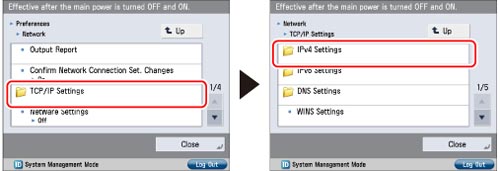
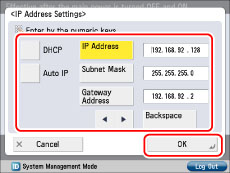
|
IMPORTANT
|
|
It takes about two minutes to check whether the Auto IP or DHCP settings can be used. If you do not plan to use one of these settings, it is recommended that you turn them off.
|
|
NOTE
|
|
If the machine is restarted after DHCP or Auto IP settings are specified, the TCP/IP Settings screen displays the IP address setting values. (If the IP address, host name, and domain name have been previously set, these will be overwritten by the setting values obtained from DHCP or Auto IP settings.)
If you use DHCP without the DNS dynamic update function, it is recommended that an identical IP address be assigned to the machine at all times. (If the IP address is not identical, the host name for the machine will not correspond to the IP address.)
If the IP address was successfully obtained by Auto IP, the subnet mask will become 255.255.0.0 and the gateway address will become 0.0.0.0.
|
|
IMPORTANT
|
|
If the IP address could not be obtained by DHCP or Auto IP, enter [IP Address], [Subnet Mask], and [Gateway Address].
|
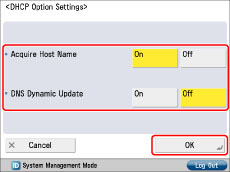
|
[Acquire Host Name]
|
You can automatically obtain the host name from the DHCP server.
|
|
[DNS Dynamic Update]
|
You can automatically register the IPv4 address, host name, domain name set for the machine in the DNS server using dynamic DNS updating. A dynamic DNS server is required for using dynamic DNS updating.
|
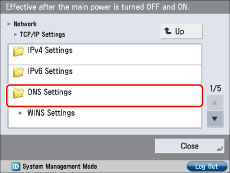
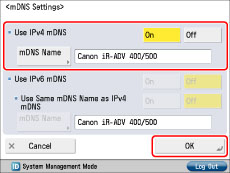
|
IMPORTANT
|
|
If you set <Use IPv4 mDNS> to 'On', the machine will not enter a complete Sleep mode.
|
|
NOTE
|
|
"Canon <product name>" is automatically set, if you do not change the mDNS name. If the same mDNS name already exists on the network, the name will become "Canon <product name>****** ("******" represents the last six digits of a MAC address.)"
e.g.) Canon iR-ADV 400/500 (7e:ec:75)
Changes in the mDNS settings become effective after the machine is restarted, after the procedure. Turn OFF the machine, wait at least 10 seconds, and then turn it ON.
|
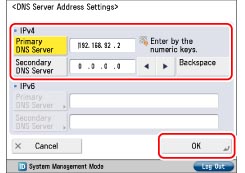
|
IMPORTANT
|
|
If you set [DHCP] to 'On' in step 5, and the DNS server IP address obtained from the DHCP server is different from the IP address set manually, the set IP address is overwritten.
If you enabled <Use IPv4 mDNS>in step 9, make sure that there are no devices on the network whose host name and mDNS name in the DNS Host/Domain Name Settings are the same. Any non-unique values set manually are automatically changed so that they are unique.
|
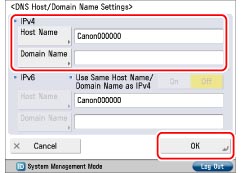
|
IMPORTANT
|
|
If you set [DHCP] to 'On' in step 5, the host name and domain name you set manually will be overwritten.
|
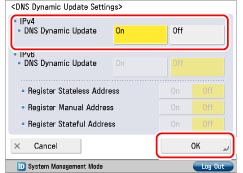
|
NOTE
|
|
If you have a DHCP server running Windows Server 2003 that uses the DHCP service and want to register the machine's DNS record, configure the following settings in the DHCP server:
In the DHCP server, right-click the [Scope] icon → click [Properties]. In the [DNS] sheet of the displayed dialog box, select [Enable DNS dynamic updates according to the settings below] → [Dynamically update DNS A and PTR records only if requested by the DHCP clients].
In the Active Directory environment, right-click the icon of the DHCP server you are using → select [Properties]. In the [Advanced] sheet of the displayed dialog box, click [Credentials]. In the [DNS dynamic update credentials] dialog box, enter the user name, domain, and password for the Active Directory.
If you have a DHCPv4 server running Windows Server 2008 that uses the DHCPv4 service and want to register the machine's DNS record, configure the following settings in the DHCPv4 server:
In the DHCPv4 server, right-click the [Scope] icon → click [Properties]. In the [DNS] sheet of the displayed dialog box, select [Enable DNS dynamic updates according to the settings below] → [Dynamically update DNS A and PTR records only if requested by the DHCP clients].
In the Active Directory environment, right-click the icon of the DHCPv4 server you are using → select [Properties]. In the [Advanced] sheet of the displayed dialog box, click [Credentials]. In the [DNS dynamic update credentials] dialog box, enter the user name, domain, and password for the Active Directory.
|
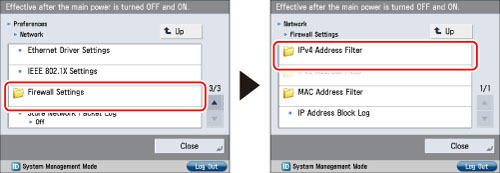
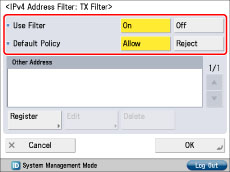 |
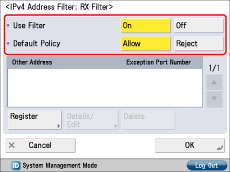 |
|
[TX Filter]
|
[RX Filter]
|
|
<Use Filter>
|
<Default Policy>
|
Settings Required after Pressing [Register]
|
|
|
Allow data transmission with all computers, but not with specified computers.
|
[On]
|
[Allow]
|
Register IPv4 address or IPv4 address prefix you want to reject.
|
|
Reject data transmission with all computers, but not with specified computers.
|
[On]
|
[Reject]
|
Register IPv4 address or IPv4 address prefix you want to allow.
|
|
Allow data reception from all computers, but not from specified computers.
|
[On]
|
[Allow]
|
Register IPv4 address or IPv4 address prefix you want to reject.
Register port number for functions you want to reject.
|
|
Reject data reception from all computers, but not from specified computers.
|
[On]
|
[Reject]
|
Register IPv4 address or IPv4 address prefix you want to allow.
Register port number for functions you want to allow.
|
|
Allow data transmission/reception with all computers.
|
[Off]
|
-
|
-
|
|
NOTE
|
|
If data transmission/reception is attempted between the device, which has the IPv4 address/port number set to be rejected, and the machine, a block log will be generated. To display the block log, "Checking the Block Log."
Information for the rejected port number is recorded in the block log only when using TCP/UDP. Port number is not recorded when using protocols which have no port number such as ICMP.
|
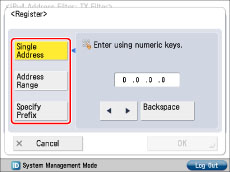 |
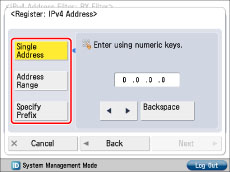 |
|
[TX Filter]
|
[RX Filter]
|
|
IMPORTANT
|
|
You can register up to 16 IPv4 addresses, IPv4 address ranges, or IPv4 address prefixes.
The value of [First Address] should be less than or equal to that of [Last Address].
If the usage of a protocol or print application is not permitted on your device, it cannot be used even after settings in [Firewall Settings] have been changed on your device. Configure the settings to permit the protocol or print application.
If you enter '255' in [Prefix Length], no IPv4 addresses will be set.
If you enter '0' in [Prefix Length], all IPv4 addresses will be set.
|
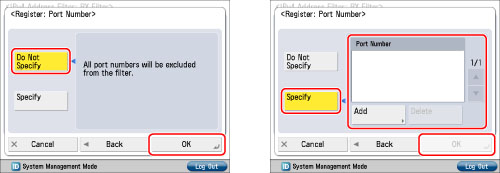
|
IMPORTANT
|
|
You can register up to 16 port numbers for IPv4 addresses, IPv4 ranges, or IPv4 address prefixes.
You can register 50 port numbers for one port number setting.
|